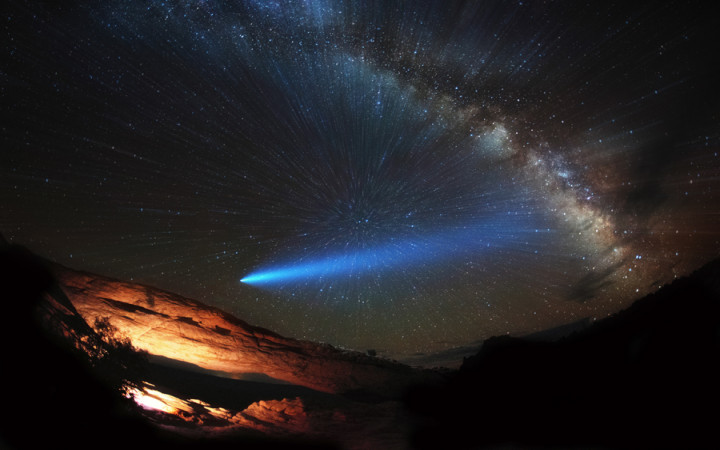Today’s Wonder of the Day was inspired by Ryan. Ryan Wonders, “how long would it take to reach the oort cloud, the barrier of our galaxy” Thanks for WONDERing with us, Ryan!
Have you ever gotten the chance to peek through a telescope pointed at the night sky? If so, you may have had the chance to see a curious object that looked a bit like a star with a long tail. What could it be? It's probably a comet!
Comets are huge chunks of rock and ice that come from the farthest reaches of our solar system and even interstellar space. In fact, some scientists believe they're leftovers from the birth of the solar system.
As a comet gets closer to the Sun, heat causes it to leave a debris trail of dust and gas. This is the signature tail we see through a telescope. Observations of comets long ago led scientists to theorize the existence of a spherical cloud of rocky, icy objects that form a shell around the Sun and our solar system.
This theoretical cloud is known as the Oort Cloud, named after Dutch astronomer Jan Oort who theorized its existence. An Estonian astronomer named Ernst Öpik also developed similar theories, so sometimes the cloud is called the Öpik-Oort Cloud.
So exactly where is the Oort Cloud? To reach it, you would have to travel to the outer edges of our solar system, way past Neptune and Pluto. Astronomers believe it begins somewhere between 2,000-5,000 Astronomical Units (AU) from the Sun. An AU is defined as the average distance between Earth and the Sun, or about 93 million miles.
The size of the Oort Cloud is hard for the human mind to imagine, because astronomers believe it could stretch out as far as 50,000 AU from the Sun. Some astronomers theorize it could extend as far as 100,000 AU or even 200,000 AU from the Sun. That puts its outer boundary at anywhere from 4 trillion miles away to over 17 trillion miles away!
How many icy objects could fit into that enormous space? Some scientists estimate there could be two trillion or more such objects in the Oort Cloud. Most of these objects are believed to be made up of ammonia, methane, and water (ice).
Since the Oort Cloud is so far away from the Sun, the objects within it are susceptible to the gravitational pulls from other stars and the Milky Way galaxy itself. Occasionally, objects will be knocked out of their orbits by these gravitational effects, sending them either out into deep space or into the solar system toward the Sun.
Objects that are knocked toward the Sun often become long-period comets (comets with orbits longer than 200 years). The observation of comets is what led Oort and Öpik long ago to theorize the existence of the Oort Cloud to explain their origin.
So does the Oort Cloud really exist? No one knows for sure. It's purely theoretical. Its great distance from Earth makes proving its existence via observation impossible with present technology.
For example, Voyager 1, the fastest and farthest space probe that's currently exiting the solar system would still need about 300 years to reach the Oort Cloud. Unfortunately, the generators that power its scientific instruments will have run out of fuel hundreds of years before it would reach the Oort Cloud.





